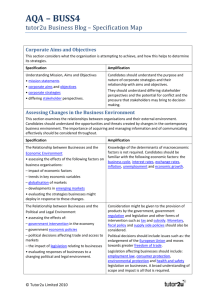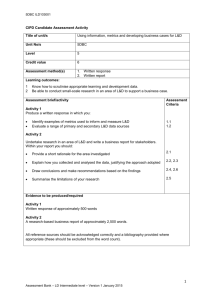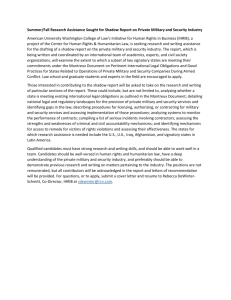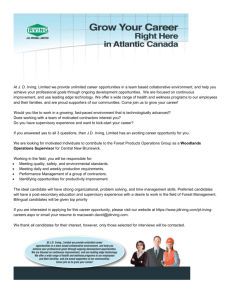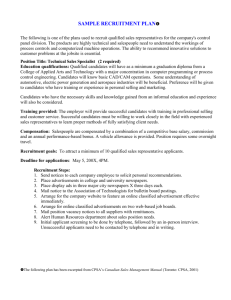tutor2u Business Blog - School
advertisement
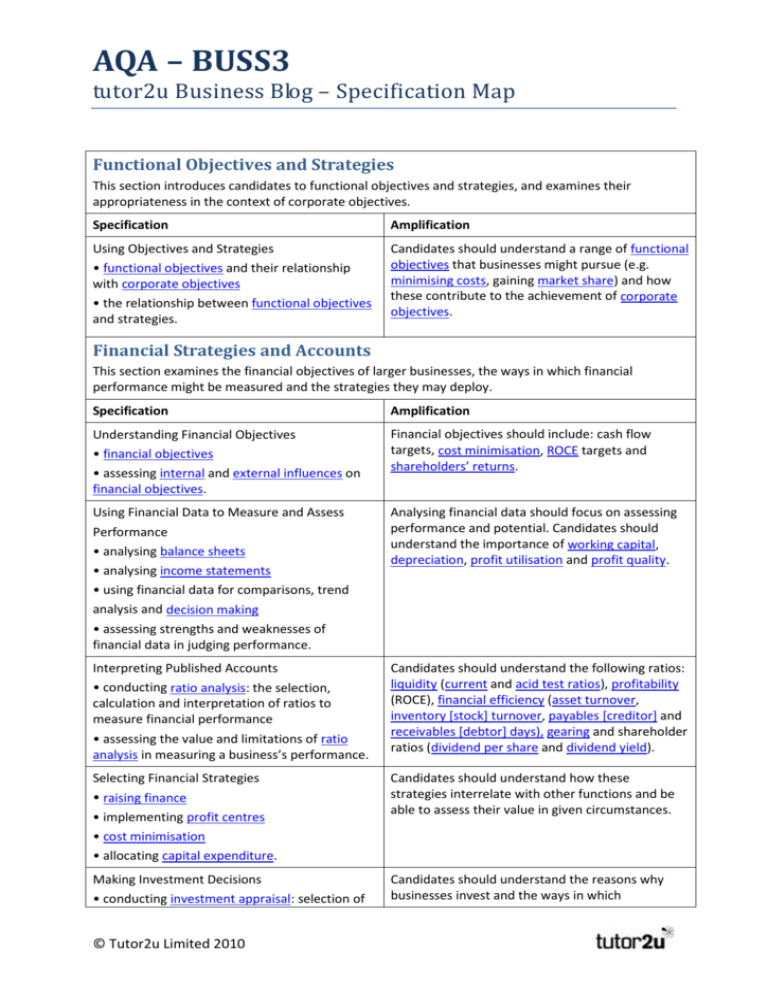
AQA – BUSS3 tutor2u Business Blog – Specification Map Functional Objectives and Strategies This section introduces candidates to functional objectives and strategies, and examines their appropriateness in the context of corporate objectives. Specification Amplification Using Objectives and Strategies • functional objectives and their relationship with corporate objectives • the relationship between functional objectives and strategies. Candidates should understand a range of functional objectives that businesses might pursue (e.g. minimising costs, gaining market share) and how these contribute to the achievement of corporate objectives. Financial Strategies and Accounts This section examines the financial objectives of larger businesses, the ways in which financial performance might be measured and the strategies they may deploy. Specification Amplification Understanding Financial Objectives • financial objectives • assessing internal and external influences on financial objectives. Financial objectives should include: cash flow targets, cost minimisation, ROCE targets and shareholders’ returns. Using Financial Data to Measure and Assess Performance • analysing balance sheets • analysing income statements • using financial data for comparisons, trend analysis and decision making • assessing strengths and weaknesses of financial data in judging performance. Analysing financial data should focus on assessing performance and potential. Candidates should understand the importance of working capital, depreciation, profit utilisation and profit quality. Interpreting Published Accounts • conducting ratio analysis: the selection, calculation and interpretation of ratios to measure financial performance • assessing the value and limitations of ratio analysis in measuring a business’s performance. Candidates should understand the following ratios: liquidity (current and acid test ratios), profitability (ROCE), financial efficiency (asset turnover, inventory [stock] turnover, payables [creditor] and receivables [debtor] days), gearing and shareholder ratios (dividend per share and dividend yield). Selecting Financial Strategies • raising finance • implementing profit centres • cost minimisation • allocating capital expenditure. Candidates should understand how these strategies interrelate with other functions and be able to assess their value in given circumstances. Making Investment Decisions • conducting investment appraisal: selection of Candidates should understand the reasons why businesses invest and the ways in which © Tutor2u Limited 2010 AQA – BUSS3 tutor2u Business Blog – Specification Map appropriate methods, calculation and interpretation of findings • investment criteria • assessing the risks and uncertainties of investment decisions • evaluating quantitative and qualitative influences on investment decisions. investment can help businesses to reach functional objectives. Quantitative measures of investment should include: payback, average rate of return, and net present value. Marketing Strategies This section considers the development of marketing strategies for larger businesses through a scientific approach to decision making. It builds upon AS Marketing materials. Specification Amplification Understanding Marketing Objectives • marketing objectives • assessing internal and external influences on marketing objectives. Internal influences on marketing should include finance, HR, operational issues and corporate objectives. External influences should include: competitors’ actions, market factors and technological change. Analysing Markets and Marketing • reasons for, and the value of, market analysis • methods of analysing trends • the use of information technology in analysing markets • difficulties in analysing marketing data. Reasons for analysing markets should include: gathering evidence for devising a new strategy, identifying significant patterns in sales. Candidates should be familiar with moving averages, test markets and extrapolation as methods of measuring and forecasting sales. Candidates should understand how correlation can be used in analysing markets. Selecting Marketing Strategies • low cost versus differentiation • market penetration • product development and market development strategies • diversification • assessing effectiveness of marketing strategies. Ansoff’s matrix should be used to assess marketing strategies in a national and an international context. Marketing strategies should consider the methods, risks and benefits involved in entering international markets. Developing and Implementing Marketing Plans • components of marketing plans • assessing internal and external influences on marketing plans • issues in implementing marketing plans. Components of marketing plans include: objectives, budgets and sales forecasts and marketing strategies. Influences on the marketing plan might include: finance available, operational issues and competitors’ actions. Operational Strategies This section considers the operational objectives and strategies that a business may use to achieve success in its particular market. It builds upon AS Operations materials. Specification © Tutor2u Limited 2010 Amplification AQA – BUSS3 tutor2u Business Blog – Specification Map Understanding Operational Objectives • operational objectives • assessing internal and external influences on operational objectives. Operational objectives should include: meeting quality, cost and volume targets, innovation, efficiency (including time) and environmental targets. Influences on operational objectives might include: competitors’ performance, resources available, the nature of the product and demand. Operational Strategies: Scale and Resource Mix • choosing the right scale of production: economies and diseconomies of scale • choosing the optimal mix of resources: capital and labour intensity. Candidates should be aware of a range of economies of scale including: purchasing, technical and specialisation. Diseconomies of scale include communication and co-ordination. Candidates should understand the benefits and drawbacks of capital and labour intensive strategies. Operational Strategies: Innovation • innovation, research and development • purpose, costs, benefits and risks of innovation. Candidates should be aware that a strategy of innovation has implications for finance, marketing and human resources. Operational Strategies: Location • methods of making location decisions • benefits of optimal location • the advantages and disadvantages of multi-site locations • issues relating to international location. The focus should be on expansion and/or relocation (including offshoring). Methods of deciding on location should take into account quantitative (investment appraisal, for example) and qualitative factors. Reasons for international location include: global markets, cost reduction and avoidance of trade barriers. Operational Strategies: Lean Production • the effective management of time • assessing the value of critical path analysis • the effective management of other resources through methods of lean production. Candidates should be able to interpret and complete critical path networks by entering ESTs and LFTs and understand the significance of critical and non-critical activities. Candidates should be aware of lean production techniques, including just-in-time production and kaizen. Human Resource Strategies This section considers the strategies available to businesses in managing their human resources. It builds upon AS Human Resources materials. Specification Amplification Understanding HR Objectives and Strategies • HR objectives • assessing internal and external influences on HR objectives • HR strategies. HR objectives might include: matching workforce skills, size and location to business needs, minimising labour cost, making full use of the workforce’s potential and maintaining good employer/employee relations. Candidates should be aware of ‘hard’ and ‘soft’ strategies to HR and © Tutor2u Limited 2010 AQA – BUSS3 tutor2u Business Blog – Specification Map the strengths and weaknesses of each. Developing and Implementing Workforce Plans • components of workforce plans • assessing internal and external influences on workforce plans • issues in implementing workforce plans • the value of using workforce plans. Candidates should be aware of the influences on workforce planning, including other functional decisions, eg innovation may require greater diversity, legislation and labour market trends including migration. Issues involved in implementing workforce plans might include: employer/employee relations, cost, corporate image and training. Candidates should recognise that these issues can have positive and negative effects. Competitive Organisational Structures • factors determining choice of organisational structures • adapting organisational structures to improve competitiveness. Methods of adapting organisational structures to improve competitiveness should include: centralisation and decentralisation, delayering and flexible workforces. Candidates should be aware of the issues involved with implementing and operating each of these approaches. Flexible workforces should include the notion of core and peripheral workers, outsourcing and home working. Effective Employer/Employee Relations • managing communications with employees • methods of employee representation • methods of avoiding and resolving industrial disputes. Candidates should understand the importance of communication in employer/employee relations. Candidates should know the advantages and disadvantages of employee representation. Methods of employee representation might include: works councils, employee groups as well as trade unions. © Tutor2u Limited 2010
